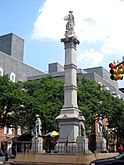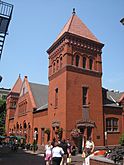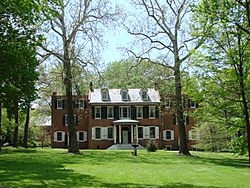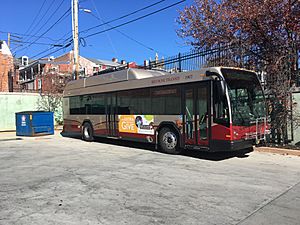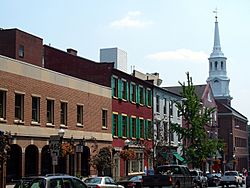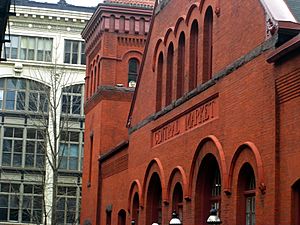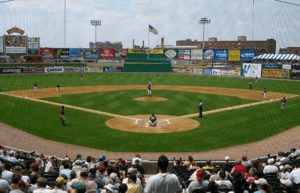Lancaster, Pennsylvania facts for kids
Quick facts for kids
Lancaster, Pennsylvania
Lengeschder
|
|||
|---|---|---|---|
| City of Lancaster | |||
|
From top, left to right: Lancaster skyline, Soldiers and Sailors Monument, Central Market, Wheatland
|
|||
|
|||
| Nickname(s):
The Red Rose City
|
|||
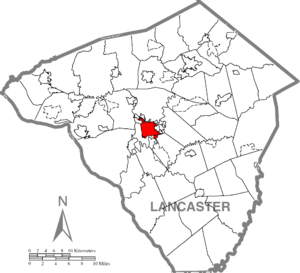
Location in Lancaster County
|
|||
| Country | United States | ||
| State | Pennsylvania | ||
| County | Lancaster | ||
| Founded | 1729 | ||
| Incorporated (borough) | 1742 | ||
| Incorporated (city) | 1818 | ||
| Founded by | James Hamilton | ||
| Named for | Lancaster, Lancashire, England | ||
| Seat | Lancaster County | ||
| Government | |||
| • Type | Strong mayor − council | ||
| Area | |||
| • City | 7.35 sq mi (19.03 km2) | ||
| • Land | 7.23 sq mi (18.72 km2) | ||
| • Water | 0.12 sq mi (0.31 km2) | ||
| • Metro | 802 sq mi (2,080 km2) | ||
| Elevation | 368 ft (112 m) | ||
| Population
(2010)
|
|||
| • City | 59,322 | ||
| • Estimate
(2019)
|
59,265 | ||
| • Rank | 10th in Pennsylvania | ||
| • Density | 8,200.50/sq mi (3,166.09/km2) | ||
| • Urban | 402,004 | ||
| • Metro | 507,766 | ||
| Demonym(s) | Lancastrians | ||
| Time zone | UTC−5 (EST) | ||
| • Summer (DST) | UTC−4 (EDT) | ||
| ZIP Codes |
17573, 17601−17608, 17611, 17622, 17699
|
||
| Area codes | 717 and 223 | ||
| FIPS code | 42-41216 | ||
Lancaster, ( lang-KI-stər; Pennsylvania Dutch: Lengeschder) also known as the Red Rose City (after the symbol of the House of Lancaster) is a city in South Central Pennsylvania, that serves as the seat of Pennsylvania's Lancaster County and is one of the oldest inland towns in the United States. With a population at the 2020 census of 58,039, it ranks 11th in population among Pennsylvania's municipalities. The Lancaster metropolitan area population is 507,766, making it the 104th-largest metropolitan area in the U.S. and second-largest in the South Central Pennsylvania area.
The city's primary industries include healthcare, tourism, public administration, manufacturing, and both professional and semi-professional services. Lancaster is best known for being the hub of Pennsylvania's Amish Country.
Contents
History
Originally called Hickory Town, the city was renamed after the English city of Lancaster by native John Wright. Its symbol, the red rose, is from the House of Lancaster. Lancaster was part of the 1681 Penn's Woods Charter of William Penn, and was laid out by James Hamilton in 1734. It was incorporated as a borough in 1742 and incorporated as a city in 1818.
During the American Revolution, Lancaster was the capital of the United States for one day, on September 27, 1777, after the Continental Congress fled Philadelphia, which had been captured by the British. The revolutionary government then moved still farther away to York, Pennsylvania.
Lancaster was capital of Pennsylvania from 1799 to 1812, after which the capital was moved to Harrisburg.
In 1851, the current Lancaster County Prison was built in the city, styled after Lancaster Castle in England. The prison remains in use, and was used for public hangings until 1912. It replaced a 1737 structure on a different site.
The first paved road in the United States was the former Philadelphia and Lancaster Turnpike, which makes up part of the present-day U.S. Route 30. Opened in 1795, the Turnpike connected the cities of Lancaster and Philadelphia, and was designed by a Scottish engineer named John Loudon McAdam. Lancaster residents are known to use the word "macadam" in lieu of pavement or asphalt. This name is a reference to the paving process named for McAdam.
The city of Lancaster was home to several important figures in American history. Wheatland, the estate of James Buchanan, the fifteenth President of the United States, is one of Lancaster's most popular attractions. Thaddeus Stevens, considered among the most powerful members of the United States House of Representatives, lived in Lancaster as an attorney. Stevens gained notoriety as a Radical Republican and for his abolitionism. The Fulton Opera House in the city was named for Lancaster native Robert Fulton, a renaissance man who created the first fully functional steamboat. All of these individuals have had local schools named after them.
After the American Revolution, the city of Lancaster became an iron-foundry center. Two of the most common products needed by pioneers to settle the Frontier were manufactured in Lancaster: the Conestoga wagon and the Pennsylvania long rifle. The Conestoga wagon was named after the Conestoga River, which runs through the city. The innovative gunsmith William Henry lived in Lancaster and was a U.S. congressman and leader during and after the American Revolution.
In 1803, Meriwether Lewis visited Lancaster to be educated in survey methods by the well-known surveyor Andrew Ellicott. During his visit, Lewis learned to plot latitude and longitude as part of his overall training needed to lead the Lewis and Clark Expedition.
In 1879, Franklin Winfield Woolworth opened his first successful "five and dime" store in the city of Lancaster, the F. W. Woolworth Company.
Lancaster was one of the winning communities for the All-America City award in 2000.
On October 13, 2011, Lancaster's City Council officially recognized September 27 as Capital Day, a holiday recognizing Lancaster's one day as capital of the United States in 1777.
Geography
Lancaster is located at 40°02'23" North, 76°18'16" West (40.039860, −76.304366), and is 368 feet (112 m) above sea level.
The city is located about 34 miles (55 km) southeast of Harrisburg, 70 miles (110 km) west of Philadelphia, 55 miles (89 km) north-northeast of Baltimore and 87 miles (140 km) northeast of Washington, D.C.
The nearest towns and boroughs are Millersville (4.0 miles), Willow Street (4.8 miles), East Petersburg (5.3 miles), Lititz (7.9 miles), Landisville (8.6 miles), Mountville (8.8 miles), Rothsville (8.9 miles), and Leola (8.9 miles).
According to the United States Census Bureau, the city has a total area of 7.4 square miles (19 km2), of which, 7.4 square miles (19 km2) of it is land and 0.14% is water.
Climate
Lancaster has a Humid continental climate (Köppen climate classification Dfa) with hot or very warm summers.
| Climate data for Lancaster, Pennsylvania (1981–2010 normals, extremes 1949–present) | |||||||||||||
|---|---|---|---|---|---|---|---|---|---|---|---|---|---|
| Month | Jan | Feb | Mar | Apr | May | Jun | Jul | Aug | Sep | Oct | Nov | Dec | Year |
| Record high °F (°C) | 70 (21) |
76 (24) |
88 (31) |
93 (34) |
99 (37) |
97 (36) |
103 (39) |
101 (38) |
99 (37) |
91 (33) |
86 (30) |
76 (24) |
103 (39) |
| Average high °F (°C) | 38.1 (3.4) |
41.4 (5.2) |
51.0 (10.6) |
62.9 (17.2) |
72.6 (22.6) |
81.0 (27.2) |
85.2 (29.6) |
83.5 (28.6) |
76.0 (24.4) |
64.9 (18.3) |
53.8 (12.1) |
42.1 (5.6) |
62.8 (17.1) |
| Average low °F (°C) | 22.0 (−5.6) |
23.8 (−4.6) |
31.1 (−0.5) |
40.5 (4.7) |
50.0 (10.0) |
59.7 (15.4) |
64.3 (17.9) |
62.6 (17.0) |
54.8 (12.7) |
43.2 (6.2) |
34.6 (1.4) |
26.3 (−3.2) |
42.8 (6.0) |
| Record low °F (°C) | −16 (−27) |
−9 (−23) |
−2 (−19) |
16 (−9) |
28 (−2) |
36 (2) |
46 (8) |
37 (3) |
34 (1) |
23 (−5) |
12 (−11) |
−3 (−19) |
−16 (−27) |
| Average precipitation inches (mm) | 2.88 (73) |
2.47 (63) |
3.27 (83) |
3.38 (86) |
3.89 (99) |
3.94 (100) |
4.50 (114) |
3.20 (81) |
4.56 (116) |
3.85 (98) |
3.60 (91) |
3.27 (83) |
42.81 (1,087) |
| Average snowfall inches (cm) | 5.5 (14) |
7.5 (19) |
1.4 (3.6) |
0.2 (0.51) |
0 (0) |
0 (0) |
0 (0) |
0 (0) |
0 (0) |
0 (0) |
0.4 (1.0) |
3.3 (8.4) |
18.3 (46) |
| Average precipitation days (≥ 0.01 in) | 9.8 | 8.5 | 9.9 | 11.3 | 12.7 | 10.7 | 10.3 | 9.2 | 9.1 | 9.3 | 10.4 | 10.2 | 121.4 |
| Average snowy days (≥ 0.1 in) | 3.0 | 2.1 | 0.8 | 0.1 | 0 | 0 | 0 | 0 | 0 | 0 | 0.2 | 1.3 | 7.5 |
| Source: NOAA | |||||||||||||
Demographics
| Historical population | |||
|---|---|---|---|
| Census | Pop. | %± | |
| 1790 | 3,762 | — | |
| 1800 | 4,292 | 14.1% | |
| 1810 | 5,405 | 25.9% | |
| 1820 | 6,633 | 22.7% | |
| 1830 | 7,704 | 16.1% | |
| 1840 | 8,417 | 9.3% | |
| 1850 | 12,369 | 47.0% | |
| 1860 | 17,603 | 42.3% | |
| 1870 | 20,233 | 14.9% | |
| 1880 | 25,769 | 27.4% | |
| 1890 | 32,011 | 24.2% | |
| 1900 | 41,459 | 29.5% | |
| 1910 | 47,227 | 13.9% | |
| 1920 | 53,150 | 12.5% | |
| 1930 | 59,949 | 12.8% | |
| 1940 | 61,345 | 2.3% | |
| 1950 | 63,774 | 4.0% | |
| 1960 | 61,055 | −4.3% | |
| 1970 | 57,690 | −5.5% | |
| 1980 | 54,725 | −5.1% | |
| 1990 | 55,551 | 1.5% | |
| 2000 | 56,348 | 1.4% | |
| 2010 | 59,322 | 5.3% | |
| 2020 | 58,039 | −2.2% | |
| Sources: | |||
As of the 2010 census, the city was 55.2% White, 16.3% Black or African American, 0.7% Native American, 3.0% Asian, 0.1% Native Hawaiian, and 5.8% were two or more races. 39.3% of the population were of Hispanic or Latino ancestry.
As of the census of 2000, there were 56,348 people, 20,933 households, and 12,162 families residing in the city. The population density was 7,616.5 people per square mile (2,940.0/km2). There were 23,024 housing units at an average density of 3,112.1 per square mile (1,201.3/km2). The racial makeup of the city was 61.55% White, 14.09% African American, 0.44% Native American, 2.46% Asian, 0.08% Pacific Islander, 17.44% from other races, and 3.94% from two or more races. 30.76% of the population were Hispanic or Latino people of any race.
Ethnic groups
The largest ethnic groups in Lancaster as of recent estimates are:
- Puerto Rican 29.2%
- German 21.2%
- African American 12.8%
- Irish 8.6%
- English 8.2%
- Italian 4.1%
- Dominican 3.2%
- Polish 2.0%
- Scottish 1.9%
- Mexican 1.8%
- Cuban 1.7%
- West Indian 1.0%
In 2010, 29.2% of Lancaster residents were of Puerto Rican ancestry. The city has the second highest concentration of Puerto Ricans in Pennsylvania after Reading. For this reason, it is sometimes referred to as the "Spanish Rose." Lancaster celebrates its Puerto Rican heritage once every year with the Puerto Rican Festival.
There were 20,933 households, out of which 31.6% had children under the age of 18 living with them, 33.4% were married couples living together, 19.0% had a female householder with no husband present, and 41.9% were non-families. 33.1% of all households were made up of individuals, and 9.9% had someone living alone who was 65 years of age or older. The average household size was 2.52 and the average family size was 3.23.
In the city, the population was spread out, with 27.5% under the age of 18, 13.9% from 18 to 24, 30.5% from 25 to 44, 17.7% from 45 to 64, and 10.5% who were 65 years of age or older. The median age was 30 years. For every 100 females, there were 95.2 males. For every 100 females age 18 and over, there were 91.4 males.
The median income for a household in the city was $29,770, and the median income for a family was $34,623. Males had a median income of $27,833 versus $21,862 for females. The per capita income for the city was $13,955. 21.2% of the population and 17.9% of families were below the poverty line. 29.2% of those under the age of 18 and 12.9% of those 65 and older were living below the poverty line. Poverty in Lancaster is twice the state's average, and public school records list more than 900 children as homeless. Although there are many Amish people from this area, not everyone from Lancaster is Amish, contrary to popular belief.
Neighborhoods

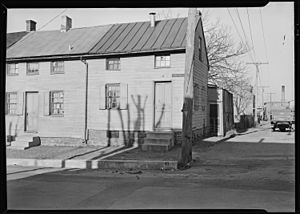
- Cabbage Hill/The Hill (Named for a favorite food of ethnic Germans in this area)
- Chestnut Hill
- Downtown/Center City
- Downtown Investment District
- East End
- Eighth Ward
- Gallery Row/Arts District
- Galebach Ward
- Northwest Corridor
- Penn Square
- Prospect Heights
- Seventh Ward
- Sixth Ward
- Uptown
- West End
- Woodward Hill
Infrastructure
Transportation
The Red Rose Transit Authority (RRTA) provides local public bus transit to the city of Lancaster and surrounding areas in Lancaster County. RRTA is headquartered outside the city of Lancaster. The Queen Street Station in downtown Lancaster serves as a transit hub for several RRTA bus routes.
Bieber Transportation Group (formerly Capitol Trailways) formerly provided intercity bus transit from the Lancaster Train and Bus Station to Reading, Norristown, Philadelphia, and New York City to the east, and York to the west; service was discontinued on April 1, 2018. Intercity bus service from York and Lancaster to New York City was restored by OurBus in July 2018.
Amtrak also serves the Lancaster Train and Bus Station, located on the northernmost edge of the city at 53 East McGovern Avenue. The Pennsylvanian, with service between Pittsburgh and New York City via Philadelphia, as well as the Keystone Service, which runs from Harrisburg to New York City via Philadelphia, both serve Lancaster. The city is served by the Lancaster Airport, located six miles (10 km) north of downtown and just south of Lititz, with commercial air service by Southern Airways Express to Washington DC via Dulles, Pittsburgh, and Nantucket on Saturdays.
Lancaster is also a hub for automobile traffic, with many major roadways passing through or around the city, including US 30, US 222, PA 283, PA 72, and PA 272.
Utilities
Electricity in Lancaster is provided by PPL Electric Utilities. UGI Utilities supplies natural gas to the city. The City of Lancaster Water Department provides water service to residents and businesses in the city. The city's Public Works department provides wastewater service to Lancaster, operating the City of Lancaster Advanced Wastewater Treatment Plant which serves the city and surrounding municipalities. Trash and recycling collection is provided by the city's Public Works department.
Historical landmarks
Many of Lancaster's landmarks are significant in local, state, and national history.
- Central Market (Lancaster) - built in 1889, it is the oldest continuously run farmers market in the United States.
- Bethel African Methodist Episcopal Church - built in 1879, the church's congregation aided freedmen migrating to the North for opportunities after the American Civil War. Their congregation had earlier aided fugitive slaves fleeing the South before the war, using their former church as a station on the Underground Railroad.
- Cork Factory Hotel - built in 1865 as Conestoga Cork Works. Later the buildings making up what is known today as Urban Place were home to Armstrong Cork Factory and Kerr Glass Company. Rezoned in 2005, Urban Place has been adapted as 49 loft-style apartments, 115,000 square feet of retail and commercial space, the Cork Factory Hotel, and Cap & Cork Restaurant.
- Fulton Opera House - the oldest continually running theater in the United States, it is one of three theaters designated as National Historic Landmarks (the others are the Walnut Street Theatre in Philadelphia and the Goldenrod Showboat in St. Louis, Missouri).
- Hamilton Watch Complex - former factory and headquarters of the Hamilton Watch Company, which in 1957 sold the world's first battery-powered watch, the Hamilton Electric 500.
- J. P. McCaskey High School - built in 1938 during the Great Depression, it is designed in the Art Deco architectural style.
- Lancaster Arts Hotel - Built in 1881, this building was the Falk and Rosenbaum Tobacco Warehouse. In October 2006, the warehouse reopened after adaptation, as Lancaster's first boutique hotel for the arts. It has 63 guest rooms (including 12 suites), an organic restaurant - John J Jeffries, and an onsite Art Gallery. It is registered with the Historic Hotels of America.
- Lancaster County Prison - built in 1849, it was styled after the Lancaster Castle in England.
- Rock Ford Plantation - built in 1794, this was the home of General Edward Hand, adjutant general to George Washington during the American Revolutionary War.
- W. W. Griest Building - listed on the U.S. National Register of Historic Places since June 25, 1999. It was built in 1925 in the Beaux-Arts style using granite, limestone, terra cotta, synthetics, and asphalt. The building is named after William Walton Griest, a former Pennsylvania representative. It is the second-tallest building in the city.
- Wheatland - the historic estate of James Buchanan, the 15th President of the United States.
Art and museums
The city of Lancaster has art, craft and historical museums. The Demuth Museum is located in the former home of the well-known painter Charles Demuth, who had a national reputation in the 20th century. Additional art museums include the Lancaster Museum of Art and the Philips Museum of Art on the campus of Franklin & Marshall College. Art students at the state-of-the-art Pennsylvania College of Art and Design present their works at the academy's gallery, which is open to the public. LancasterARTS, a non-profit organization founded in 2002, promotes contemporary arts and crafts.
Lancaster city has a thriving art community. Gallery Row on the 100 block of North Prince St. features a block of art galleries, and the city proper has over 40 galleries and artists studios. The Galleries host a "First Friday" each month, extending business hours to exhibit new artwork and new artists to the public.
The Lancaster County Quilts and Textile Museum, completed in 2007, celebrates the art of the hand-sewn quilts and other textile items produced by women of the region's Amish and Mennonite communities. The Lancaster Mennonite Historical Society Museum and the Heritage Center Museum display artifacts and interpret the region's unique history. Children can have a hands-on experience with educational learning at the Hands-on House, also known as Children's Museum of Lancaster. Nature and geology-minded visitors can view the more earthly exhibits of the Louise Arnold Tanger Arboretum and the North Museum of Natural History and Science.
Upon completion, the Lancaster County Convention Center will incorporate the Stevens and Smith Historic Site. This museum that will include the preserved home of US Senator Thaddeus Stevens and his companion Lydia Hamilton Smith. In addition to its exhibits, the underground portion of the site will feature a recently discovered Underground Railroad feature: a converted water cistern used in the antebellum years to hide fugitive slaves on their way to freedom.
In Lancaster County, the Landis Valley Museum in Manheim Township has exhibits that interpret the county's history and culture, especially as a center of ethnic German Amish and Mennonite culture.
Inventions
- The first battery-powered watch, the Hamilton Electric 500, was released in 1957 by the Hamilton Watch Company.
- Peeps, an Easter confection shaped as marshmallow chicks covered with yellow sugar, were invented by the Rodda Candy Company of Lancaster in the 1920s. In 1953, Rodda was purchased by Sam Born, the Russian immigrant who invented ice cream "jimmies", and production was moved to Bethlehem, Pennsylvania.
Sister cities
Economy
Lancaster City has been in the process of recreating itself, particularly since 2005, with a growth of specialty shops, boutiques, bars, clubs, and reinvestment in downtown institutions and locations. In 2005 the creation of "Gallery Row" solidified the status of Lancaster as an arts destination. The art community continues to thrive and expand.
There are also plans to convert an area of unused polluted industrial grounds (i.e., brownfields), which were once occupied by Armstrong World Industries, into playing fields for Franklin & Marshall College. This action is expected to take up most of the former industrial site. The Northwest Corridor will be developed with funds from Lancaster General Hospital. The hospital plans to create a mixed-use development which will add several city blocks to Lancaster's grid.
Another brownfield site is Burle Business Park, the city's only commercial and industrial park. Devoted to adaptive re-use, this facility originally opened in 1942 as a U.S. Navy electronics research, development and manufacturing plant that was operated by RCA. The Navy facility was purchased after World War II by RCA. Burle Business Park was originally occupied by Burle Industries, the successor company to the RCA New Products Division following the 1986 acquisition of RCA by General Electric Company (GE). The GE acquisition of RCA resulted in the divestiture of this facility and the electronic business, but GE retained certain environmental liabilities that were subdivided into a separate parcel. Burle Industries is a major manufacturer of vacuum tube products, including photomultiplier tubes, power tubes, and imaging tubes. and is the largest U.S. manufacturer of photomultiplier tubes. Burle Industries has completed a voluntary clean-up under the Pennsylvania Land Recycling Program ("Act 2").
Shopping
In addition to Lancaster's boutiques, vintage shops, and art galleries (Gallery Row), Park City Center is the largest enclosed shopping center in South Central Pennsylvania. The mall includes more than 150 stores and is anchored by Boscov's, JCPenney, and Kohl's. Park City opened in September 1971.
Built in 1889, the Lancaster Central Market is the oldest continuously operated farmers market in the United States, and many tourists come to purchase the handmade Amish goods that are not commonly found elsewhere. Central Market is listed with the National Register of Historic Places, and its towers are of the Romanesque Revival style. The market underwent renovations beginning in July 2010.
Lancaster also has two outlet shopping centers, both of which are located in East Lampeter Township on U.S. Route 30. Tanger Outlets is home to about 65 stores. Rockvale Outlets contains over 100 stores and restaurants.
Top employers
According to Lancaster's 2018 Comprehensive Annual Financial Report, the top employers in the city are:
| # | Employer | # of Employees |
|---|---|---|
| 1 | Lancaster General Hospital | 8,802 |
| 2 | Dart Container | 1,961 |
| 3 | County of Lancaster | 1,907 |
| 4 | Nordstrom, Inc. | Data Not Available |
| 5 | Masonic Villages | 1,685 |
| 6 | School District of Lancaster | 1,662 |
| 7 | LSC Communications (formerly RR Donnelley) | Data Not Available |
Sports
| Club | League | Sport | Venue | Capacity | Founded | Championships |
|---|---|---|---|---|---|---|
| Lancaster Barnstormers | ALPB | Baseball | Clipper Magazine Stadium | 6,000 | 2005 | (2) 2006, 2014 |
| Lancaster Kings | TBL | Basketball | Pucillo Gym (Millersville) | 3,000 | 2022 | |
| Pennsylvania Classics AC | NPSL | Men's soccer | Georgelis Law Firm Stadium (Landisville) | 2,000 | 2021 | |
| Lancaster Inferno FC | UWS | Women's soccer | Crusader Stadium | 500 | 2008 | |
| Lancaster Lions | ABA | Basketball | Ephrata Recreation Center (Ephrata) | 200 | 2020 | |
| Red Rose Thunder | ABA | Basketball | Warwick High School (Lititz) | 200 | 2019 |
Baseball
The Barnstormers played their inaugural season in 2005, filling Lancaster's 44-year period without professional baseball since the demise of the Red Roses. Their main Atlantic League rival is the Revolution from nearby York.
Lancaster is the hometown of Major League Baseball alumnus Tom Herr. He played for the St. Louis Cardinals for a majority of his career. He also played for the Minnesota Twins, Philadelphia Phillies, New York Mets, and the San Francisco Giants . Herr subsequently coached the Hempfield High School Black Knights baseball team for several years. He also managed the Lancaster Barnstormers in their first season. In 2006, Herr led the club to their first-ever Atlantic League championship over the Bridgeport Bluefish.
Cycling
The Lancaster Bicycle Club hosts an annual Covered Bridge Metric Century bicycle race. In 2010, more than 2,500 riders participated.
The city of Lancaster hosted the Tom Bamford Lancaster Classic, an international, professional bicycle racing event held each June since 1992. It was part of the 2006–2007 UCI America Tour and the 2007 USA Cycling Professional Tour.
Golf
Professional golf is well represented by the Professional Golf Association's Jim Furyk. He placed 4th in the 1998 and 2003 Masters tournament, won the 2003 U.S. Open, placed 4th in the 1997, 1998, and 2006 British Open, and placed 6th in the 1997 PGA championship. Furyk also won the Vardon Trophy in 2006. He is an alumnus of Manheim Township High School, located in the immediate suburb of Manheim Township.
The 2015 U.S. Women's Open was held at the Lancaster Country Club.
Soccer
Lancaster has both a men's and a women's semi-professional soccer club. Pennsylvania Classics AC play in the National Premier Soccer League, a fourth-tier in the American soccer pyramid. Lancaster Inferno FC play in United Women's Soccer, a second-tier league. Both clubs play their home games at Crusader Stadium on the campus of Lancaster Catholic High School. The city also has an amateur team called Lancaster City FC that plays other regional clubs in the United Soccer League of Pennsylvania.
Field hockey
In 2013, USA Field Hockey announced their intentions to move their national training center for the United States women's national field hockey team to Lancaster County. They signed with Spooky Nook Sports through 2022 after searching for many years for a northeastern site.
Amateur sports in Lancaster
Lancaster's suburban area hosts several amateur sports teams. Ice hockey is represented by the Central Penn Panthers, a member of the junior-level Atlantic Metropolitan Hockey League, and both the Lancaster Firebirds, and Regency Panthers youth amateur ice hockey organization of the USA Hockey's Atlantic District. American football is represented by the Lancaster Lightning, a member of the semi-professional North American Football League, that plays in nearby Kinzers. A close cousin of American football, rugby, is represented by the Roses Rugby Football Club of the Mid Atlantic Rugby Football Union, of which the Roses RFC were the 2005 champions. Roller derby is represented by the Dutchland Derby Rollers, an all-female roller derby team which plays to raise money for various charities, and is currently ranked #23 in the world by Derby News Network.
Historical Lancaster teams
The Lancaster Red Roses of the Eastern Professional Baseball League are the most well-known of Lancaster's defunct teams. They played from 1906 to 1909, and from 1940 to their last season in 1961. The Red Roses were called the "Lancaster Maroons" from 1896 to 1899 and the "Lancaster Red Sox" in 1932.
The "Lancaster Red Roses" was also the name of a basketball franchise in the Continental Basketball Association (at that time, the Eastern Professional Basketball League) from 1946 to 1949, and from 1953 to 1955. The CBA later hosted another Lancaster team called the Lightning from 1981 to 1985. The Lightning later moved to Rockford, Illinois, where they played until the 2007 season. The Storm of the Eastern Basketball Alliance played from 1997 to 2000, winning the league championship in 1999. The last professional basketball team to call Lancaster home was the Liberty, who played as a member of the now-defunct Global Professional Basketball League in 2009.
Education
Education in Lancaster is provided by many private and public institutions. The School District of Lancaster runs the city's public schools. Established in 1836, it is the second oldest school district in Pennsylvania.
The local high school campuses are McCaskey and McCaskey East. Lancaster Catholic High School has a long history in the county; it was founded in 1926. It currently falls under the jurisdiction of the diocese of Harrisburg. With a P-12 enrollment of more than 500 students, Lancaster Country Day School is one of the region's largest independent nonsectarian schools. Founded in 1908 as the Shippen School for Girls, the school became coeducational and relocated from downtown Lancaster to its Hamilton Road address in 1949. La Academia Partnership Charter School, opened in 1998, serves grades 6–12. It is the only public charter school in Lancaster County, and is open to any student residing in the county. Manheim Township School District is a four-year public high school located in Lancaster. It is the only high school in the Manheim Township School District. It is supported by a 7th and 8th grade middle school, a 5th and 6th grade intermediate school, and five elementary schools.
In 2008, Manheim Township High School was named one of the top 505 high schools in the nation by U.S. News & World Report. It is also known for graduating professional golfer Jim Furyk.
On May 13, 2015, Lancaster City was named by GoodCall as the number one best city in the country to be a teacher. The top 10 list was based on average annual teacher salary, available teaching jobs, teaching jobs per capita, high school graduation rates, cost of living and amenities. Data was gathered from the U.S. Census, Indeed.com, the National Center for Education Statistics, and WalkScore.com.
The Lancaster area hosts several colleges and universities, including Consolidated School of Business, Franklin & Marshall College, Lancaster General College of Nursing & Health Sciences, Lancaster Theological Seminary, Lancaster Bible College, Pennsylvania College of Art and Design, Thaddeus Stevens College of Technology, Millersville University of Pennsylvania, Central Pennsylvania College, Elizabethtown College and the Harrisburg Area Community College.
Notable people
- Benjamin Smith Barton (1766–1815), was an American botanist, naturalist, and physician. He was one of the first professors of natural history in the United States
- James Buchanan, (1791–1868) was an American lawyer, diplomat and politician who served as the 15th president of the United States.
- Adam Cole, (b 1989) is an professional wrestler currently signed to All Elite Wrestling (AEW).
- Jonathan Groff, (b 1985) is an actor and singer.
- Travis Jankowski, (b 1991) is an American professional baseball outfielder for the New York Mets of Major League Baseball (MLB).
- Taylor Kinney, (b 1981) is an American actor and model.
- Maria Louise Kirk (1860–1938), usually credited as Maria L. Kirk, was an American painter and illustrator of more than fifty books, most of them for children
- Thomas Mifflin (1744–1800) was an American merchant, soldier, and politician from Philadelphia, Pennsylvania.
- August Burns Red, is an metalcore band from Lancaster, Pennsylvania, formed in 2003.
- Anna Diller Starbuck, (1868–1929) was a composer, music educator, organist, and pianist. She was one of the first two women to attend Harvard University.
- Thaddeus Stevens, (1792–1868) was a member of the United States House of Representatives from Pennsylvania.
- Charlotte White (1782–1863) was the first unmarried American woman missionary sent to a foreign country.
| TV stations | ||||
|---|---|---|---|---|
| Call letters | Channel | Network | Location | Owner |
| WGAL 8 | 8.1 | NBC | Lancaster | Hearst Corporation |
| WGAL–DT2 | 8.2 | MeTV | Lancaster | Hearst Corporation |
| TeleCentro TV | Comcast 949 | Public access | Lancaster | Spanish American Civic Association |
Lancaster is part of the Harrisburg-Lancaster-York market. In addition to WGAL and TeleCentro TV, the city is served by CBS/MyNetworkTV/CW affiliate WHP-TV 21, ABC affiliate WHTM-TV 27, PBS member station WITF-TV 33, and Fox affiliate WPMT 43. WPMT is based in York, while the other major stations are based in Harrisburg.
Radio stations
See also
 In Spanish: Lancaster (Pensilvania) para niños
In Spanish: Lancaster (Pensilvania) para niños



